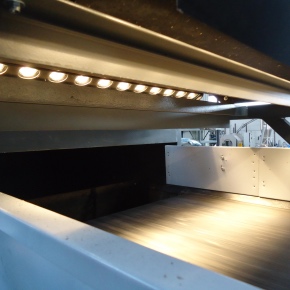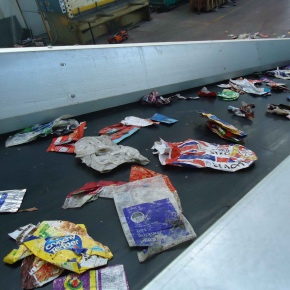
Developments in marker technologies for sorting plastic packaging
Axion Consulting has suggested that developments in marker technologies for sorting plastic packaging could be valuable when it comes to increasing recycling rates. These marker technologies could lead to higher quality and value in recycling.
According to Richard McKinlay, Head of Engineering & Research at the resource recovery specialist, existing Near Infrared technology has a lot of ‘unexploited potential’ in recovering more packaging such as polypropylene (PP) from rigid plastics, polyethylene (PE) and PP films, which would go a long way to increasing recycling rates.
For many years, NIR technology detecting polymer type was sufficient to recover high quality PET, HDPE, LDPE film and PP, but this is changing due to the diversification in the plastics packaging market.
A more complex waste stream has been developed that contains many different components, as a result of innovation in packaging. The growing use of PET in non-food products can lead to challenges when using recycled PET in new food packaging.
Richard explains: “This shift has brought forward the need for an alternative to NIR that can sort material on more criteria, to protect existing recycling processes and drive up quality to access higher value markets.”
Research is currently ongoing in to marker techniques that provide detailed information on what packaging can and cannot be recycled, for example fluorescent pigments and digital watermarks.
Fluorescent pigments can be detected under ultraviolet light and are specially chosen for optimum performance while minimising cost and are safe for food contact applications.
Digital watermarks are patterns that can be applied in label or packaging design, or directly to the polymer surface. Having minimal visual impact, they can be detected by a camera and created at very low cost. Each marker can hold a large amount of data.
The development of fluorescent pigments is further ahead than digital watermarking, with projects such as the Polymark project almost completed.
Richard explains: “There is, therefore a better understanding of efficacy of fluorescent pigments. There are still many unknowns about watermarking but it could be a powerful tool in the future due to the amount of data it can hold and brand owners can gauge how much of their packaging is recycled.”
The same watermark can be used by manufacturers during production, and by consumers to give product information such as nutrition of recipes. You could even develop a ‘smart bin’ where you show the bin the packaging and it tells you whether it can be recycled.
However, this is only part of the solution, packaging needs to be fundamentally recyclable in an economic way, and so compromises should not be made because of the ability to sort the different materials.
Markers offer a useful way to detect differences between food and non-food packaging, such as PET drinks bottles and PET detergent bottles, but Richard warns that taking this route could result in manufacturers using packaging that has less value at end of life in the future.
“Marker technology should be seen as a way to safeguard quality of materials for recycling. The only way to increase recycling rates is to do more sorting on more of the plastic fractions that are currently going to energy recovery because it’s not economically viable to recover them. In order for this to happen, a fundamental change in the economic drivers for recycling is needed,” Richard concludes.
Axion
Tenax Road
Trafford Park
Manchester
M17 1JT
Visit Supplier's page
Latest news

17th April 2025
Nuaire shares expertise at Specifi Mechanical Services events in 2025
Indoor air quality and ventilation manufacturing specialist Nuaire is pleased to be exhibiting at the Specifi Mechanical Services events once again in 2025.
Posted in Air Conditioning, Articles, Building Industry Events, Building Industry News, Building Products & Structures, Building Services, Exhibitions and Conferences, Facility Management & Building Services, Heating, Ventilation and Air Conditioning - HVAC, Restoration & Refurbishment, Retrofit & Renovation
15th April 2025
West Fraser: CaberDek earns top marks from Home Counties carpentry specialist
A specialist carpentry sub-contractor covering housing sites across a large swathe of the Home Counties has come to value CaberDek from the West Fraser range for a variety of reasons: not least because the high quality panel product doesn’t destroy his operatives’ electric saws!
Posted in Articles, Building Industry News, Building Products & Structures, Building Systems, Case Studies, Restoration & Refurbishment, Retrofit & Renovation, Roofs, Timber Buildings and Timber Products, Wooden products
15th April 2025
GEZE: The Role of Access Control Systems in Enhancing Building Safety
Jane Elvins, Specification and Business Development Manager at GEZE UK, delves into the role of access control systems in enhancing building safety…
Posted in Access Control & Door Entry Systems, Architectural Ironmongery, Articles, Building Industry News, Building Products & Structures, Building Services, Doors, Facility Management & Building Services, Health & Safety, Restoration & Refurbishment, Retrofit & Renovation, Security and Fire Protection
11th April 2025
Don’t Do a Dave! It’s Time to Lock FIT Show 2025 in Your Calendar!
It’s that time again – FIT Show is back! You could be forgiven for thinking there won’t be much new to see when FIT Show returns to the NEC from 29 April – 1 May. Wrong!
Posted in Articles, Building Industry Events, Building Industry News, Building Products & Structures, Building Services, Continuing Professional Development (CPD's), Exhibitions and Conferences, Information Technology, Innovations & New Products, Restoration & Refurbishment, Retrofit & Renovation, Seminars, Training
 Sign up:
Sign up: 